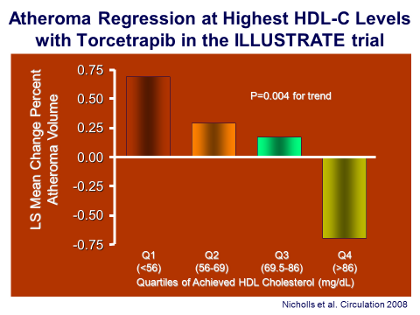Barter - Figure 17 - ILLUSTRATE Text
Finally, one final bit of evidence about the functionality of the HDL particles in patients treated with torcetrapib comes from one of the imaging studies, the Investigation of Lipid Level management USing coronary ultrasound To assess Reduction of ATherosclerosis by CETP inhibition and HDL Elevation (ILLUSTRATE) trial.[20] This was an intravascular ultrasound (IVUS) study looking the effects of torcetrapib treatment on carotid intimal medial thickness (cIMT) as a measure of “atheroma volume.” Although the ILLUSTRATE investigators found no overall evidence of regression of cIMT with torcetrapib, nevertheless, as shown in the Figure, in those patients in whom the achieved serum HDL cholesterol level was >86 mg/dL (the highest quartile of HDL achieved with torcetrapib), that group of people showed a statistically significant regression of atherosclerosis. Again, this does not prove that HDL particles in CETP-inhibited subjects retain their functionality, but it is certainly not consistent with impaired functionality.
J Clin Lipidol. 2011; 5(6).References
[20]Nicholls SJ, Tuzcu M, Brennan DM. Cholesteryl Ester Transfer Protein Inhibition, High- Density Lipoprotein Raising, and Progression of Coronary Atherosclerosis. Circulation. 2008;118:2506-2514.
